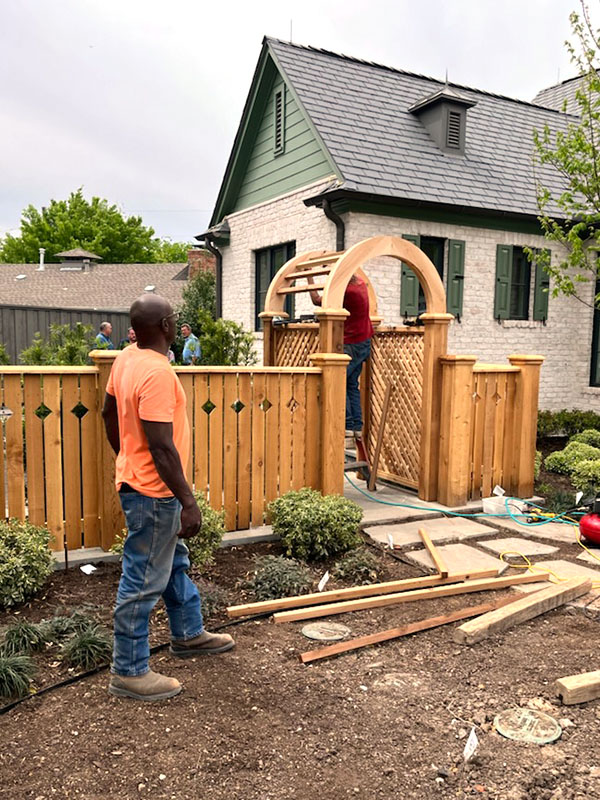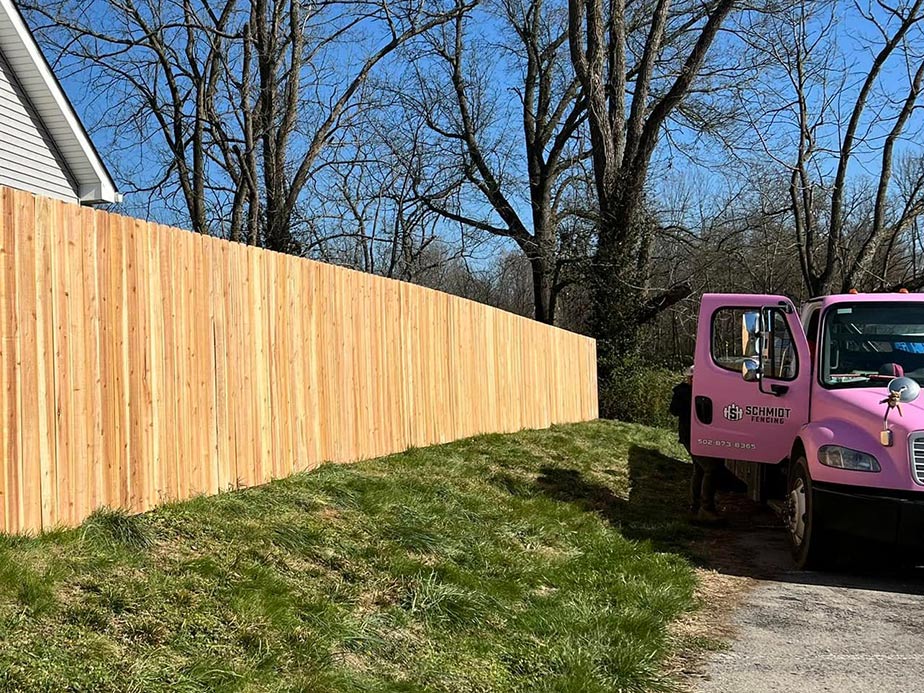Ratings That Help You Find the Most Trusted Fence Contractor Near Me
Ratings That Help You Find the Most Trusted Fence Contractor Near Me
Blog Article
Exactly How to Identify Usual Problems That Require Immediate Fencing Repair Service
When it comes to preserving your fencing, it is vital to detect issues prior to they come to be bigger problems. Consistently looking for indicators of deteriorating timber, leaning panels, or rust can conserve you money and time in the future. You could not realize exactly how weather and insects can endanger your fence's honesty. Let's check out the usual signs that show your fence requires prompt focus, so you can maintain your residential property secure and looking its best.
Signs of Rotting Wood in Wooden Fences
Have you discovered your wooden fencing looking a bit shabby? If so, it could be time to look for signs of deteriorating timber. Initially, examine the base of the articles and panels for soft areas. That's a clear indication of rot if you press on the wood and it really feels squishy or falls apart. Next, seek staining or dark spots on the wood-- these frequently signal dampness damage. Take notice of any type of peeling paint or coating, as this can subject the wood to further degeneration. Furthermore, a pungent, moldy scent can show fungal development. Don't fail to remember to inspect connections and joints; if they hang or crumbling, the wood under is likely endangered. By catching these indications early, you can protect against a lot more substantial damages and maintain your fence standing strong. Regular maintenance is key to expanding the life of your wood fence.
Leaning or Tilting Fence Panels
If you've observed your fence panels turning or leaning, it's important to understand what caused it. This concern might show underlying structural damages that requires your interest. Let's explore the usual causes and the repair service options readily available to get your fencing back in shape.

Sources Of Leaning Panels
It's usually an indicator of underlying concerns that need dealing with when you notice your fencing panels tilting or leaning. One typical reason is insufficient water drainage; extreme water can erode the soil around the fencing articles, compromising their assistance. An additional perpetrator could be strong winds or tornados that press versus the panels, especially if they're not appropriately secured. Furthermore, the natural settling of dirt over time can cause articles to shift, causing a tilt. Bugs, like termites, can endanger the integrity of wooden panels, triggering them to lean. Ultimately, bad installment practices might lead to panels not being firmly set, leaving them susceptible to leaning under pressure. Address these issues promptly to preserve your fence's stability.
Signs of Structural Damage
Seeing leaning or tilting fencing panels can be alarming, as these concerns commonly suggest structural damage that needs immediate attention. When your fencing begins to lean, it might signify that the articles are shifting or that the dirt around them has deteriorated. Pay close interest to spaces in between articles or panels, as these can also recommend instability. deck builder. Additionally, check for fractures or splintering in the wood, which can deteriorate the total structure. It might endanger the stability of the fencing if you discover corrosion or corrosion on steel elements. Keep in mind, ignoring these signs can cause much more extreme damages down the line, so it's necessary to assess the scenario without delay and take activity before it intensifies
Fixing Options Available

Rust and Deterioration in Metal Fences
If you possess a steel fence, you may notice corrosion and deterioration sneaking in over time, particularly if it's exposed to wetness. These concerns not just influence the appearance of your fencing but can likewise compromise its architectural integrity. To determine rust, look for reddish-brown places or patches, which suggest the steel is oxidizing. Deterioration can spread rapidly if left without treatment, damaging the fencing and leading to pricey repairs.To tackle corrosion and rust, you must clean the affected areas with a wire brush and use a rust-inhibiting primer. Once the guide dries out, take into consideration painting the fence with a weather-resistant paint to protect it even more. Normal maintenance, such as evaluating for signs of rust and repairing paint as required, will aid expand your fence's lifespan. Resolving these problems promptly guarantees your metal fencing stays solid and visually appealing for years to come.
Fractures and Splits in Plastic Secure Fencing

Reasons For Plastic Damages
Plastic fencing is popular for its longevity, yet it can still struggle with splits and divides as a result of different elements. One major cause is severe temperature changes. It can compromise the material over time when vinyl broadens in the heat and agreements in the cool. In addition, direct exposure to harsh sunlight can cause UV destruction, making the plastic brittle. Physical effects, like hefty branches or unintended collisions, can also create splits. Poor installation or using low-grade materials can exacerbate these concerns. Age plays a role; older vinyl fencing is a lot more susceptible to damage. Regular inspections can aid you identify these aspects prior to they bring about considerable problems. Take positive steps to ensure your fencing continues to be strong and intact.
Fixing Cracks Properly
Although cracks and splits in your plastic fencing can be worrying, resolving them quickly can stop more damages and keep the fence's appearance. Evaluate the dimension of the crack. For little fractures, a vinyl fixing kit usually includes glue that can bond the sides, offering a smooth solution. Clean the location thoroughly before using the adhesive, guaranteeing it adheres effectively. For bigger divides, you may need to make use of a plastic spot. Cut the spot to size, use glue around the edges, and press it securely onto the split. Enable it to cure according to the manufacturer's guidelines. Routine maintenance and fast repairs can prolong your fence's lifespan, maintaining it looking excellent for many years to find.
Loosened or Missing Fencing Articles
Missing or loosened fencing posts can weaken the security of your whole fencing framework. It's essential to resolve the concern right away if you see any articles leaning or tottering. Look for any kind of indicators of activity, as this can result in more damage with time. You can easily examine the trouble by providing each article a gentle shake-- if it feels unsteady, it's time to take action.For missing out on articles, you'll require to replace them immediately to keep your fence's honesty. When you mount brand-new blog posts, see to it they're firmly anchored in the ground with concrete or crushed rock for added stability. If a post is loosened, tighten it by adding additional assistance or driving it deeper into the ground.Ignoring these problems can cause larger issues, like gaps in your fence or perhaps complete collapse. Maintain an eye on your blog posts and stay proactive about repair services!
Damages From Weather Condition and Natural Environment
Weather condition and natural environments can create mayhem on your fence, causing various forms of damage that call for punctual focus. Hefty rain can cause wood to rot, making it unsteady and weak. Snow buildup may flex or break panels, while strong winds can uproot fencing posts or trigger sections to lean.If you observe splits or splintering in wood fences, it signifies drying as a result of intense sun exposure. At the same time, metal fencings can corrosion if protective finishes diminish, particularly in humid or seaside areas.Inspect your fencing regularly after storms or severe weather condition to catch any damage early. Addressing these issues rapidly can conserve you from costly fixings down the line. Don't wait until a little problem turns right into a major one; remain proactive and maintain your fencing in top form to keep both capability and curb charm.
Insect Infestation and Termite Damage
When you notice indications of insect invasion or termite damages, it's necessary to act rapidly to stop more damage. Look for mud tubes along your fence or hollow-sounding wood, as these show termites are at job. You may also see small holes or frass, which is termite droppings resembling sawdust. If you identify any of these indicators, it's time to examine the damage.Don' t wait until it's far too late; insects can jeopardize your fence's honesty. Evaluate the surrounding area for ants or beetles, as they may be adding to the trouble. If you presume a problem, consider getting in touch with a pest control specialist to verify and deal with the issue.Repairing or changing afflicted areas of your fencing quickly not just restores its strength but also stops insects from spreading out further. Remain attentive to keep your home pest-free and safe.
Often Asked Inquiries
How Typically Should I Evaluate My Fence for Damages?
You need to check your fence at least two times a year, ideally throughout spring and autumn. Normal checks help you find damages early, saving you time and money on repair services while maintaining your home's look and security.
Can I Repair a Fencing Myself or Hire an Expert?
If you have the right tools and skills, you can most definitely repair a fence yourself. Employing an expert warranties high quality work and saves you time, specifically for intricate fixings or considerable damage.
What Tools Are Required for Basic Fence Repairs?
For fundamental fence repairs, you'll require devices like a hammer, screwdriver, pliers, a saw, a level, and determining tape. deck builder. Depending upon the repair service, you may also need nails, screws, or replacement boards
Just How Much Does Fencing Repair Normally Cost?
Fence repair prices differ widely, however you can anticipate to pay in between $200 and $1,500 depending on products, labor, and degree of damage. It's wise to obtain numerous quotes for the very best bargain.
When Is the most effective Season for Fence Fixes?
The ideal time for fencing fixings is during light climate, typically in spring or very early loss. You'll avoid extreme temperature levels, making it much easier to function and making certain the materials established appropriately for lasting longevity (deck builder). Seeing leaning or tilting fence panels can be alarming, as these problems commonly suggest architectural damage that requires instant focus. Absent or loose fencing posts can undermine the stability of your whole fencing framework. Snow buildup might bend or break panels, while solid winds check here can root out fence posts or create areas to lean.If you see splits or splintering in wooden fencings, it's an indicator of drying out due to extreme sun direct exposure. Metal fencings can rust if safety coverings use off, particularly in moist or seaside areas.Inspect your fencing routinely after storms or severe weather condition to catch any kind of damages early. Fencing repair work expenses vary widely, however you can expect to pay in between $200 and $1,500 depending on products, labor, and extent of damage
Report this page